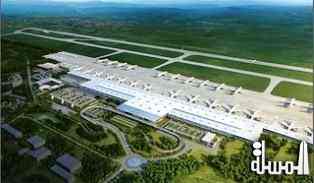
Ethiopia s planned mega airport to boost aviation and manufacturing sectors
Ethiopia has announced plans to construct a USD 4 bn mega airport in Addis Ababa that is intended to serve as many as 120 mn passengers annually when it opens in more than a decade s time.
The project reflects the scale of Ethiopia s economic ambitions and will form an important component in developing the country s tourism and light manufacturing sectors, as well as supporting the government s aim to transform Addis Ababa into an aviation hub for the African region.
The project nonetheless is at risk of delays due to challenges securing finance, while the huge costs entailed threaten to exacerbate foreign exchange shortages in the coming years.
The planned airport is set to be one of Ethiopia s most ambitious projects, surpassed only by the USD 4.8 bn Grand Ethiopian Renaissance Dam and demonstrates the government s ongoing commitment to state-led development through investment in huge infrastructure projects.
The new airport is planned in addition to an ongoing USD 350 mn expansion of the current Bole International Airport in Addis Ababa, illustrating the importance the government has attributed to planned aviation sector growth.
The current airport expansion is set to increase capacity from 6 million passengers annually to 22 mn by 2018. The two developments combined aim to transform Addis Ababa into one of the largest aviation hubs in Africa, with the new airport consisting of four runways, several passenger terminals and an airport city on the outskirts of the capital.
Airport to bolster manufacturing and aviation sectors
The construction of the airport is consistent with Ethiopia s aims to develop its tourism and light manufacturing sectors. In August the culture and tourism ministry announced it planned to triple Ethiopia s annual foreign visitors to 2.5 mn by 2020, declaring tourism represents a core pillar of the government s growth strategy.
Tourism currently generates USD 2.9 bn for the economy and several international hotel chains have set up operations in the country in recent year. Increases to freight capacity will likewise support the light manufacturing sector, for which the government has already attracted several global brands and where Unilever, General Electric and GlaxoSmithKline are all planning investments that will supply international markets.
The new airport is also intended to support the state-owned national carrier Ethiopian Airlines to maintain its position as the leading airline in Africa. At a time when other major regional airlines, including South Africa Airlines (SAA) and Kenya Airways, are scaling back operations or facing financial difficulties, Ethiopian Airlines reported record profits of USD 175 mn in 2014/15.
Of the four African airlines that carry more than five million passengers annually, Ethiopian Airlines has doubled its passenger traffic since 2009 and increased the number of aircraft in its fleet, while the other three – SAA, Kenya Airways and Royal Air Maroc – have seen virtually no growth. With the arrival of the new airport, Ethiopian Airlines will be well positioned to consolidate its market share, benefiting from increased passenger traffic and air freight.
This is likely to see Addis Ababa emerge as the principle aviation hub in East Africa, overtaking Nairobi over the next decade as passenger traffic surges.
The growth of these three sectors over the past decade has depended heavily on infrastructure improvements made under the 2010-2015 Growth and Transformation Plan (GTP I). The plan saw around 15 percent of GDP spent annually on public works projects, with a focus on road, railway and power projects.
The development of infrastructure combined with the associated increase in trade with Asian markets have been vital to attracting manufacturing companies and increasing passenger numbers on flights bound for Addis Ababa.
The new cabinet appointed this month is set to reveal the second phase of the Growth and Transformation Pan (GTP II) in the coming weeks, covering the five-year period from 2015-2020. The details of GTP II have not yet been revealed, but the airport is expected to be its flagship project.
Project financing and foreign exchange shortages to remain challenges in the near term
Despite the government s clear commitment to infrastructure development, concerns persist over the effective implementation of construction projects. Many targets for GTP I were missed and are now expected to form part of GTP II, while power supply remains a major issue.
GTP II is thought to be no less ambitious and, in addition to the airport, includes the USD 1.8 bn Gilgel Gibe 3 dam, a raft of geothermal, solar and wind projects, and a vast house building programme.
These various projects will put enormous pressure on Ethiopia s public finances, which are already strained following GTP I. In its Article IV consultation from September 2015, the IMF reported Ethiopia s public debt-to-GDP ratio was already at 50 percent and GTP II would see this increase further.
Concerns around the sustainability of these debts could create challenges in securing finance for the new airport, particularly considering that even with passenger growth rates of 10 percent annually, it would still take at least two decades for the new airport to reach its full annual capacity of 120 mn.
Without an immediate demand for the new airport, Ethiopian officials may struggle to secure finance from foreign lenders at concessional rates.
As with GTP I, both the new airport and GTP II are likely to depend heavily on domestic funds to finance projects. The absorption of funds by large infrastructure projects has created huge liquidity problems in Ethiopia over the past five years, resulting in delays to imports and difficulties for the private sector to access finance.
These restraints have been compounded by banking regulations that require banks to pay an additional 27 percent of each loan to private companies into state bonds to fund the government s growth plans, a requirement that frequently deters banks from lending to the private sector.
With little sign the government is willing to ease restrictions on the banking sector, access to finance and liquidity will remain among the core barriers to entry as the government presses ahead with its growth plans over the next five years.








